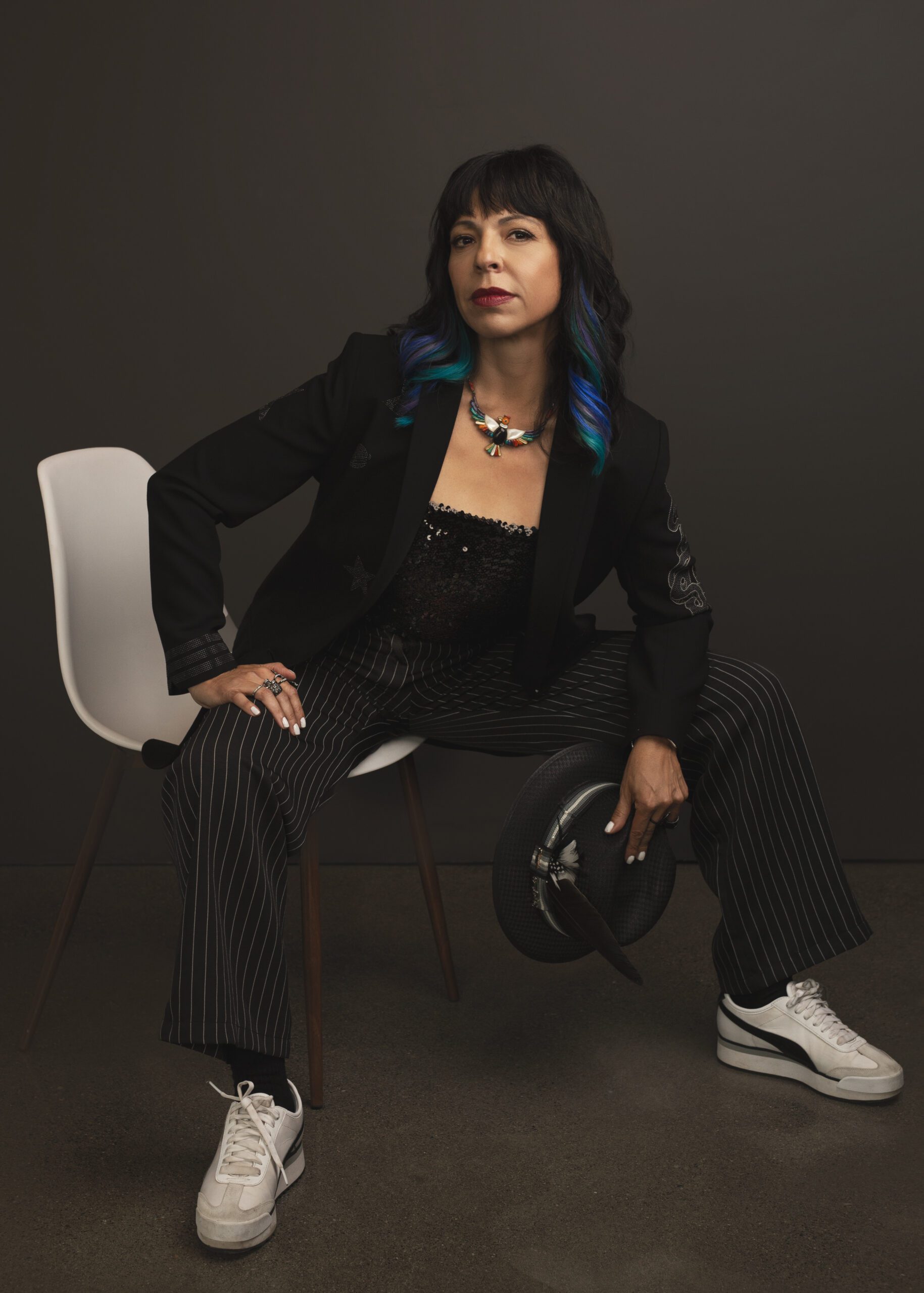
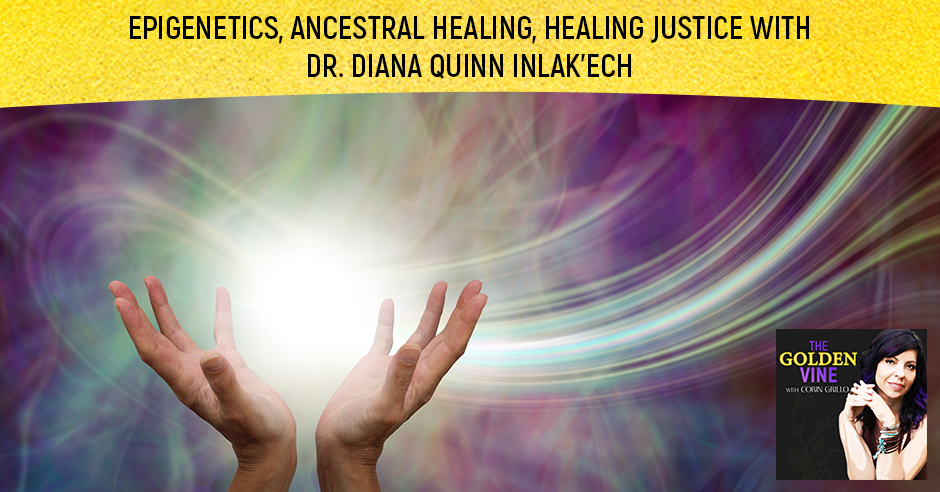
Patterns persist through generations by genetics and heredity. In this episode, Dr. Diana Quinn Inlak’ech joins Corin Grillo to talk about this and how it relates to healing. Dr. Diana is a naturopathic doctor offering holistic health consultation and somatic bodywork. She is also a collaborator of HealingbyChoice!, is a circle of women and gender non-conforming people of color health and healing practitioners. Dr. Diana explains how our ancestral experiences are passed down through generations, and takes a closer look at epigenetics, ancestral healing, and healing justice with Corin.
—
Listen to the podcast here:
Epigenetics, Ancestral Healing, Healing Justice With Dr. Diana Quinn Inlak’ech
You’re going to meet a close friend of mine, where we have had many journeys in person together. We’ve traveled a lot together. Usually, there’s a spiritual context to it. We’ve gone through pilgrimages. We’ve witnessed the first solar eclipse together, but the reason why I’m bringing her on is that to me, she represents the perfect balance of science and authentic spirituality. She’s a doctor. She’s a community builder. She’s a healing justice warrior, even a social justice warrior. She’s coming to talk to you about epigenetics and the emerging science of it. Also, how it relates to the ancestral wounding, both individually, like on your personal level as well as collectively, which we’re seeing a lot of collective multigenerational wounding get activated and coming up to the surface. I thought it would be important to have her come on because she’s someone that I trust. I know that she’s the real deal. She’s been doing this work for a long time. She’s consistently reimagining, reviewing and reinvisioning what needs to happen for equality for us all.
She also has an extraordinarily interesting and provocative input, which I want us all to be pushed to reimagine who we are and our stake in the game. There’s a lot going on in the world and Diana‘s perspective is an important one. What’s cool is that she doesn’t speak for herself. She speaks for many others. She also shares a way that you can work with your own ancestral wounding in a sweet, practical, and respectful way. She also gives some cool resources for you to further educate yourself on what’s happening in the world and how you can participate in whatever part of the movement you would like to participate in and how you can do that. Diana stands for diversity and about every realm that you can think of. What a perfect moment for her to share her amazing wisdom and her incredible education in both science, spirituality and bringing forth this cool way for us to reimagine the collective wounding and what to do about it. Here she comes.
—
We want to get into this beautiful topic. I want to find out, how did you get involved in epigenetics? How did you learn about it? We can then talk about what it is.
To frame myself and where I’m coming from and my perspective and this, my name is Diana Quinn Inlak’ech. I live in Anishinaabe territory, also known as Ann Arbor, Michigan. I’m a naturopathic physician and a practitioner of multiple healing modalities including semantics, bodywork, and various energy medicine techniques. My perspective coming to epigenetics was by way of the research science in the naturopathic field and nutritional science field that was beginning to understand what is called Single-Nucleotide Polymorphisms or SNPs. SNPs are genetic.
They’re part of the actual DNA, so that’s not quite the same thing as epigenetics, but SNPs are these various polymorphisms or sometimes they’re called mutations that are associated with disease or illness. Many of them are located between the genes in the DNA sequence, not the actual gene itself. It’s like this intergenic space. These SNPs, as we’re coming to understand more about these mutations or variants, we’re learning that they’re modifiable by lifestyle factors including nutrition, stress, environmental exposures and all of these different parameters that we can influence through a healthy lifestyle, prevention, nutrition, herbs and so on.
I am coming at this from a naturopathic medicine and a prevention perspective. That’s what got me interested in the whole emerging field of epigenetics, which is influenced by those same factors. Many of which are modifiable, but also it brings to light disparities around access, risk, and exposure. If we’re talking about, for example, environmental toxins being a risk factor that has an adverse effect on epigenetics or expression of SNPs, people who are most likely to be living in spaces where they’re getting these exposures are probably less likely to have access to healthy organic food or whatever.
Let’s talk about that because it sounds like you’re going down the road of healing justice and I’ve always been fascinated by that. That’s not something I have been surrounded by. Can you tell us a little bit more about the healing justice part of your work and passion?
I think that this has been my orientation forever since I was a young adult. I’m a second-generation Mexican-American. I acknowledged the intersecting identities that I exist within that have given me privilege like I had access to education, cisgender, but as a person of color, I’ve experienced prejudice and oppression. It wasn’t until the adult years that I came to understand the extent of assimilation and cultural loss that my family and the historical threatening for that. I have always been a social justice advocate, warrior or activist throughout my life. I took a period of time to study medicine and even though alternative medicine is a holistic, whole-person and all of these mind, body spirit, it is still part of the medical-industrial complex and still informed by capitalism and by systemic racism, homophobia, transphobia, fatphobia, all of it.
I’m learning that and reframing my orientation to working with people that are like me, queer BiPAC people. With the social justice orientation, led me to the healing justice world, which frames that this is a lineage that hearkens back to work of queer, radical black people in the South, the Kindred Healing Justice Collective by Cara Page, and then at the 2010 US Social Forum in Detroit. It was codified into a set of principles essentially and the Allied Media Conference. Many of my peers and colleagues in the healing justice space have been in this work for solidly a few years.
[bctt tweet=”Traumas, either lived personal experiences or inherited traumas, are stored in the body.” username=””]I’m a little newer to this orientation, but it’s a politicized framework that recognizes economic and racial injustice, seeks to transform, intervene, and respond to generational trauma and violence within movements, communities. Essentially, it’s also embedded in the regeneration of restoring our traditions of resiliency practices that had been lost or stolen. We’re saying not only have our people been marginalized and experience harm and systemic oppression, also our modes were taken, deemed illegal or what have you.
It was demonized and stripped away. It goes deep. I love that you are in the process of reclaiming that, not just as yourself, but also as part of this movement that is in the process of rising. I know you and you’ve been doing this work for a while. I would love to see your transformation in the sense that you work your own process of dismantling decolonizing and stepping in as one of the leaders in your community. You are co-creating and collaborating inside your community. It’s wonderful that you have that many people out there doing that.
I feel quite humbled and honored to be in this work and to follow the lead of many thinkers, activists and organizers who have come to this long before I did. Also, who helped me reconsider my thinking about how I orient to even the professionalization and certificationism of the healing arts. There’s so much at play. This movement is powerful and continues to expand and grow throughout this moment in particular. We’re building a national network of healing justice practitioners who are stepping in at this moment as you were speaking to civil rights moment around action and more people waking up to the struggle that has been there for hundreds of years. It is mobilizing around the simple belief that Black Lives Matter and taking to the streets, probably doing something. I hope that the momentum is not a moment, but a movement and it continues so.
So far so good. I don’t know if I’ve ever been more grateful for social media than I am now and seeing some of the sharing that’s going on. I know that my feed is vetted. It’s cultivated. Personally, I am happy with the information that’s being shared and at the level that it’s being shared, which in the past we didn’t have that opportunity. I do see more people becoming informed and also more people getting activated because of it. From my perspective down on the ground, that’s looking a little more like movement-ish. From your perspective, what do you feel? I wanted to have you on because of the connection between epigenetics, multigenerational trauma, we’re seeing this play out in many ways. I think many of us individually, for me as a brown woman, I’m getting reactivated. I’m having to relook at things and how I am performing in this culture with the intersectionality that you talked about earlier. Can you tell us a little bit more about epigenetics and the connection between how to work with that or look at it through a multigenerational experience?
The backdrop of epigenetics, the term itself means above the genome. This is a simplified take. It’s looking at the way that lived experience is transmitted or inherited. Basically, it’s made heritable from one generation to the next without changing the DNA. We’re not talking about re-sequencing or mutations or changing the genetic code. We’re saying, “If you experienced stress or trauma, if you have food insecurity, environmental toxin exposure, and all of these things, it is going to affect the next generation.
There are measurable ways in which that gets conveyed. Some of the research science in this field, for example, Rachel Yehuda out of Mount Sinai in New York, did some groundbreaking research looking at descendants of Holocaust survivors and finding that people’s stress response was altered. They weren’t there, but their predecessors in their lineage had this extremely traumatic experience and it changed the way their HPA axis, their cortisol response works in a fashion that makes them more prone to disease, illness, mental, emotional, physical imbalance.
That’s interesting Diana because I’ve been doing intuitive work for a long time, especially when I was at the peak of doing one-on-one practice and working on ancestral healing in energy medicine. Some things become clear. You don’t have the science behind it, but it is like, “Here are these spirits taking me all the way back.” I was sitting with this wonderful Jewish woman who was anxious, but her problem was deep anxiety all the time. When I was working with her spirit, it took me back to the Holocaust.
I didn’t know if I was like, “Am I making this up?” I said, “They’re taking me back to a moment where everything was taken from you where you were enslaved.” She said, “My grandfather was a Holocaust survivor.” I didn’t know that at that time. That for me was not the science behind it, but it was proof that sometimes your problem is not your problem. That was the beginning stage of my work as a healer that a lot of the problems or issues that we’re carrying, we don’t get to claim that we’re the first one with it that we can look deeper at this issue.
The patterns persist through the generations. The key that I want to hold with this is that it’s both/and because it’s inherited trauma. Sometimes that can also help contextualize like, “I don’t even understand why I have this reaction to something in my body because it’s not coming from my lived experience. It’s coming from an ancestral experience that I’m living out. It is like my ancestors are living through me.” That can have both the trauma piece or the dysregulation, but also the resilience because it’s like we get both. I’ve also tried to frame like, “There is some powerful medicine that those ancestors carried that lived through those experiences that they also pass down that we can claim, activate and work with.”
I love that science is emerging showing this to us. It’s true. We come from thousands of years of strength and resilience that’s why we’re standing here. We can adapt, shift and change. I feel like what’s required of all of us is an extreme level of adaptation and things are not business as usual and it’s wonderful. On the one hand, we need disruption in order to get more into alignment. We have all this strength behind us, but we also have all of this pain. Diana, from your perspective, how do we rectify this pain? When you look at what is happening down on the ground, how do you make those connections in your own mind? How do you frame what’s happening to us as a collective and what to do about it?
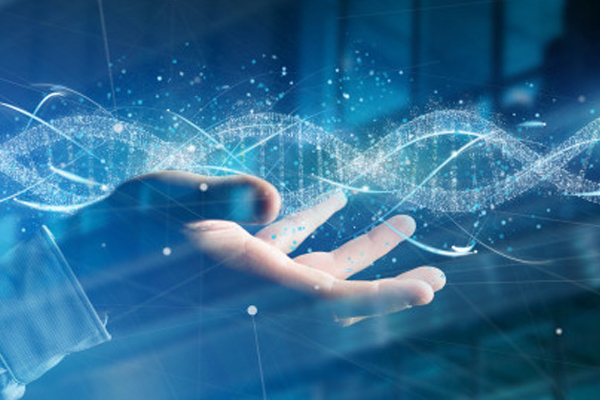
Epigenetics And Healing: Epigenetics looks at the way that lived experience is transmitted or inherited.
I think that what we’re experiencing collectively in this time is this surfacing of and reckoning with those collective, historical, intergenerational, institutional traumas that we hold that are demanding, uprooted, dissolved, composted, and examined. This is our work collectively and we each have individual work as well. For black indigenous and people of color, a lot of that work is healing and moving through a lot of the activation that is coming up in this time. I think that this is also what we’re talking about with this ancestral memory that is present in times when our people have historically experienced some of the atrocities that came with colonization, land theft, genocide, the slave trade for hundreds of years. That’s just talking about this country, the United States.
If you want to frame it in a larger context, there are many ways for those of us that have European ancestry or mixed ancestry. We’re also contending with hundreds of years of trauma that occurred throughout Europe, like against each other before the British, Spanish, and Portuguese exported that out and began the project of colonization. All of this is having a historical framework for that and one of the resources I’m looking for in my book was An Indigenous Peoples’ History of the United States by Roxanne Dunbar-Ortiz. It is a great framework and also Resmaa Menakem talks about that a little bit in his book, My Grandmother’s Hands: Racialized Trauma. I’ve been working on this book. I’ve been juggling many balls so I have not dedicated enough time to finish it. When I read Resmaa’s book, it was the closest thing to what I’ve been working on talking about epigenetics and intergenerational trauma, the pieces and personal individual trauma, and doing ancestral work and then framing it within this Polyvagal somatic framework.
What does Polyvagal mean?
The Polyvagal Theory is a framework that was developed by Stephen Porges. The vagus nerve, the tenth cranial nerve, which is the autonomic nervous system regulator of autonomic tone. Between sympathetic fight or flight, parasympathetic rest and digest, and then also the dorsal vagal reaction, which is the freeze response. When we’re talking about trauma, either our lived personal experience or these intergenerational inherited traumas, they’re stored in the body. We all have the modalities. The energy work is powerful and brilliant and I certainly bring that into the work that I do. For my own experience and also working with clients, I’ve found somatic practices such as breathwork, singing, dance, movement, humming, swaying, rocking, all of these things. These are ancient and traditional modes of healing, like a white guy who’s a scientist didn’t discover this. Humans have known this forever and science is just catching up and incorporating those modalities on the ground to help us move through and heal is powerful.
It’s not simply powerful. I notice there’s a craving for it. There’s a part that’s something is clear and deep has been missing. Some of our soul has been missing. In some of those simple practices, like singing, dancing or coming back to the Earth, embracing the animism of the Earth like “She’s alive. She’s listening.” At least in my communities, I’m seeing a lot of reawakening. People are speaking about it. More people are having even more experience with animals. Nature is coming back to life for those who are paying attention and doing the work.
It’s profound. There’s also some urgency to this because if we don’t collectively remember that the Earth is alive and drastically changed, not only the way that we’re relating to each other and our human societal constructs of hierarchy, greed, and all of that. Also, our impact on the planet. There are things that need to be changed. I do believe that needs to come about through consciousness shift and it’s relational. It’s not just carbon neutral. There are things that we need to do on a practical level, but it’s also relational both with each other and with the planet.
It’s true. I was doing it when the whole COVID breakout happened. Ever since then, when I’m doing channeling work, it’s the Earth that’s coming through. It’s the Earth, the power animals or the spirit animals, and the messages and the power that’s coming through is like, “Big mama’s awake. She’s throwing whatever she can to get your attention.” On the one hand, the disruption, the chaos is necessary in order for transformation, but I still feel this holding, this energy that’s working it’s best to help us through so we can get it.
At least, I’m holding the vision for that to happen, for more people to snap open and go, “We’re alive. We need to change our relationship with ourselves, with each other and with the planet.” You’re doing your thing and you’re doing a great. Every time I talked to you, you are like, “I have to go do this.” You’re showing up for your community. Tell me, for you, when it comes to epigenetics on the micro-scale, person-to-person, when you’re doing healing work for someone, what are the practices that you do? What are some of the beauty in working at the ancestral level to support people?
Some of that is what we’re talking about because it’s about relationships and reconnecting ourselves in a lineage. Some people have a strong cultural tradition or practice where ancestral reverence and lineage is upheld and maintained, but most of us colonize contemporary Western culture and don’t have that. It’s been that linkage and connection has been lost and broken or severed intentionally. A lot of that relationality and ancestral practices have been lost. This is what has brought me to this work for many years. It’s mostly because of the way that my ancestors talked to me. The practice that I’ve been in with them is not showing up and taking care of our end of that relationship. It is part of the problem of the mess that we’re in.
You were speaking about animism, remembering the Earth is alive and the being hood or sentience and intelligence in everything on this planet. That includes our ancestors and our ancestral lineages and how those are persistent and still present. I am speaking from my own experience and I had a dream. I think I’m meant to bring this in because I dreamed that we were having this conversation. I was talking about my ofrenda, which as a Chicana who has been in a practice of trying to situate myself within some ancestral lineage that had been lost through assimilation, proximity to whiteness and moving away from indigenous practices that included those practices of ancestral care and reverence.
[bctt tweet=” If we don’t collectively remember that the earth is alive and drastically change, it’s going to impact our planet.” username=””]Moving back toward them, in the dream, it was describing my big, beautiful ofrenda. For me, that’s a lot of it. It was re-cultivating those practices and working with folks on doing that. It doesn’t matter if you don’t have names, faces, pictures or something that has been passed through that’s tangible. I work with people that are adopted. I work with people who are African descendants here in America who don’t have a framework. When there has not been a continuous lineage, there’s not necessarily stories and genealogy through knowing that those people existed. Reaching out to them with your heart and creating a spiritual practice of showing up, bringing gifts, putting out an altar, they’re coming. We don’t have to do our DNA testing and have scientific factual information. In fact, there are lots of reasons we might not want to do that. Sometimes that’s part of it, but in the practice of ancestral repair, it’s about intentionality, relationality, and how you show up.
I’m going to have to agree. Even in my own practice and some of the work that I do there, folks usually can feel the change, the difference when you make that connection. When you ask for the support and when you build that relationship, it’s not obvious yet. It is obvious when you start doing that work. I love that you’re saying that even if you’re adopted, they still show up. Can you give our readers a simple ofrenda or gift and walk them through a simple practice they could start right away?
Many traditions will have a practice of creating a little altar and putting something on the altar that represents each element so water, fire and wind. This is part of the Mexican tradition. There are specific ways that’s done, but I want to also speak to the importance when we’re doing this work. I’ll speak to European descendants. I have mixed ancestry, both indigenous Mexican, Spanish colonizer and British settler. It’s reconciling and working with the legacies and doing also some reparation work for the merit of my lineage that has called me into my practice.
It’s important when we are cultivating a spiritual practice that we try to either bring in elements directly from our own lineage only or something that’s completely neutral like four elements. It’s crucial to be cognizant about the legacy of appropriation that can happen particularly for those of us who have been severed from cultural contexts. I would put a lot of European descendants in that because there are this hunger, yearning and grasping, but if you look at the roots, even throughout Europe in many hundreds of years ago, those folks traditions, there are herbal medicines that are being used. It’s not as much but folks all over the world have burned plants for ceremonial purposes.
When you track it all back before colonization.
Especially when we want to and being asked, this is the time to be cognizant. We can be spiritual and highly conscious and working toward this elevation of consciousness. At the same time, living in physical bodies in relational ways with other human beings and being cognizant of not reproducing harm. It’s like both/and, so making the ofrenda, your altar with something simple if you don’t have a known tradition from your ancestral lineage, then keeping it neutral and sitting at it and meditating for a few minutes.
You can light a candle or throw some flowers on there. My mom was a smoker, so sometimes I’ll give her a little cigarette or something, but if you keep it honest, authentic and simple, I like the simplicity.
My experience is that once you do that, they will start showing up and giving you more information. I can’t tell you how many details about the ancestry and people coming out of the woodwork seemingly randomly once I dedicated myself to this practice. It’s uncanny because they’re listening. One other thing that I would say about that is if there are difficult ancestors or folks in the lineage that have done harm or who may need some work and remediation. We may want to cultivate our relationship with more healthy and grounded folks first and also have boundaries with dead folks, just the same way you would with live folks. Don’t have the altar in your bedroom and have it there all the time if you don’t want them hanging on.
I like what you’re saying, having boundaries. I’m not sure if we made this clear. You light a candle. You maybe have some pictures of folks that you do know, if not, you light a candle or have a glass of water, whatever you want to do. That’s simple and feels good, but what is the practice? Do you say, “Hi ancestors, I’m here?”
It can be as simple as saying, “Hi.” It can be singing a song that is a traditional song from your lineage if you have such a thing. It could be something as simple as showing up and saying, “Hello.” For folks who don’t have historical factual information who don’t have a narrative who doesn’t have names who don’t have pictures, that’s not a hindrance especially for folks that are skilled at seeing or traveling with non-local consciousness. You will have no problem making contact with folks by showing up with intent. Making offerings is always a good plan. If it’s putting out food or water, it’s cultivating the intention to honor your folks that matters.
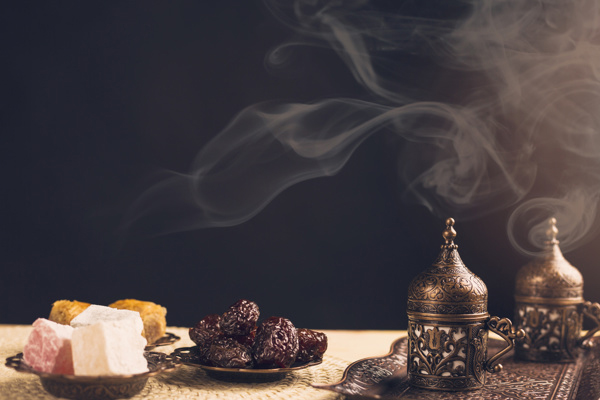
Epigenetics And Healing: Some folks have strong cultural tradition where ancestral reverence is upheld and maintained, and not taking care of our end of that relationship is part of the reason we’re in the mess that we’re in.
I think the pain that you’re seeing or that we’re seeing of not being connected to those things or to the planet. There’s a lot of repair work we all need to do and come aware of. Diana, I want to thank you for all of the wisdom that you shared so far and ask if there’s something that our readers can do to support whatever work that you were doing out there? If there are movements out there that you want us to pay attention to, what can you lead us to?
I am part of a healing vestas collective of women of color and gender-nonconforming people based out of Detroit called Healing By Choice. The website is HealingByChoiceDetroit.com. You can find out about our work, make donations if you’re inclined to support community care in that way. I’m also a part of the care team for TRACC for Movements, which is Trauma And Crisis Care for Movements, which serves black indigenous and people of color. The Two-Spirit LGBTQ plus community and organizers and activists by providing one-to-one peer support as well as training for healers and practitioners who are oriented toward doing work within their communities in movement spaces. Whether it’s frontlines on the ground, in actions or backlines, ongoing, continuing care to support people that are healing through some of these generational and historical woundings. You can check out those sites and make donations. We have online training and offerings available to download if people are interested. They can also check out my website, which is DrDianaQuinn.com. I’m also on social media.
You’re also doing one-on-one.
I am doing a little bit of that, but I have many different hats that I’m juggling with. I’m also doing some writing and a little bit of teaching. I am doing remote console work virtually over Zoom a bit. I have limited hours because I’m doing a lot of other things.
You are doing a lot and we’re grateful that you are out there.
I have newsletters too. If they want to keep in touch, they can go to my website and sign up for that.
Thanks for sharing all your goodness and for giving us all these cool and important resources and important provocative things for us to think about for ourselves. How do you recommend someone? If someone is feeling like, “I want to be part of the movement and not just be part of the moment.” What do you recommend for people and how they find their unique way to ensure what’s happening now is that movement?
There are many different ways to plug in. I think that part of it depends to some extent on where people are coming from. My answer to that question might be different based on someone’s social identity because I think BiPAC people have different work to do in this moment than European descendant or white people who live with white privilege. For those people, I would say it’s unpacking and examining some of the inheritance around whiteness and white advantage. It is not part of the work that they’ve done so far. There are many resources available, SURJ, which is Showing Up for Racial Justice. Their website is ShowingUpForRacialJustice.org.
They have wonderful scaffolding for allies and accomplices who are newer to the work with wonderful book lists, resources, and suggestions for people who want to understand what their orientation is to that. A lot of people who don’t have necessarily background or context, they misunderstand what racism is and they think that it’s this good person, bad person thing. What it is it’s the byproduct of systemic and structural institutions based on advantage. It’s not necessarily about being hateful or intolerant, things are set up to advantage some people by disadvantaging other people. You’re doing that work and then finding out how to plug in. Sometimes it’s making donations or showing up and being supportive to the mission that has been outlined by Black Lives Matter, Movement for Black Lives or indigenous orgs or other groups.
It’s an interesting time and we’re all going to do our best and then even better sometimes. Thanks, Diana, for bringing your genius into our classroom. I wish you and the work that you’re doing, sending many blessings to you too. I know you need it. You’re all out there all over the place.
Important Links:
- Diana Quinn Inlak’ech
- Kindred Healing Justice Collective
- Allied Media Conference
- An Indigenous Peoples’ History of the United States
- My Grandmother’s Hands: Racialized Trauma
- The Polyvagal Theory
- HealingByChoiceDetroit.com
- TRACC for Movements
- Two-Spirit
- DrDianaQuinn.com
- ShowingUpForRacialJustice.org
About Diana Quinn Inlak’ech
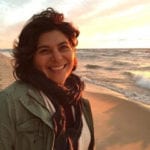 Dr. Diana Quinn Inlak’ech is a licensed Naturopathic Doctor offering holistic health consultation, somatic bodywork, and decolonized healing modalities. She is a graduate of the National University of Natural Medicine (NUNM) in Portland, Oregon and has been in practice since 2005. Her practice is trauma-informed with an anti-oppression, healing justice lens grounded in intersectional feminism.
Dr. Diana Quinn Inlak’ech is a licensed Naturopathic Doctor offering holistic health consultation, somatic bodywork, and decolonized healing modalities. She is a graduate of the National University of Natural Medicine (NUNM) in Portland, Oregon and has been in practice since 2005. Her practice is trauma-informed with an anti-oppression, healing justice lens grounded in intersectional feminism.
She provides safer space to those who have been marginalized in medical-industrial complex spaces including the 2SLGBTQIA+ community, Black, Indigenous and people of color, trauma survivors, differently-abled folks, and people of size (as a HAES advocate).
She is a core collaborator with HealingbyChoice!, a community of women of color and gender nonconforming healing practitioners who offer a range of healing modalities for self-care and the reduction of racial harm in mind, body, spirit, and institution. She also provides 1-1 care and training for practitioners with TRACC (trauma and crisis care) for Movements. More information can be found at her website drdianaquinn.com and on social media (IG, FB, Twitter) @drdianaquinn
PS – AllConnect.com created an educational guide that focuses on online safety tips and support groups for LGBTQIA+ youth. Online resources have become vital for the youth to maintain their mental and emotional health, especially for those who experience isolation and less support from their families or friends.
Access the free LGBTQIA+ Online Resource here:
https://www.allconnect.com/
This guide is completely free to use and includes:
- Detailed Infographics with Online Safe Spaces and Support Groups
- Information on Homelessness, Parental Guidance, and Safety Tips
- Downloadable Checklist of U.S. LGBTQ+ Youth Community Centers


